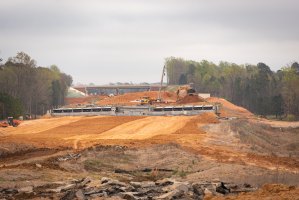More than a year in the making, a draft blueprint to rid North Carolina’s transportation sector of carbon emissions is largely a “plan to make a plan” that doesn’t reflect the urgency of the climate crisis, advocates say.
A January 2022 executive order issued by Gov. Roy Cooper requires a Clean Transportation Plan that will chart “actionable strategies” to zero out transportation emissions by midcentury.
But a letter from the Southern Environmental Law Center, signed by more than a dozen leading environmental and social justice groups, says the draft “misses the mark” and “requires significant change” before a final version is submitted to the governor on April 7.
The plan sets the pace of change on a host of complex policies governing the transportation sector, which recently surpassed power plants as the largest source of climate pollution in the state.
Rather than recommend concrete short-term action items, the plan suggests that teams and task forces assemble in the next three years and conduct further study, the letter says.
“North Carolina has spent more than enough time preparing to tackle the problem,” the groups write. “Now is the time for action.”
Sign up for Energy News Weekly
Get the most important energy news of the week delivered directly to your inbox.
There is no silver bullet for curbing pollution from the transportation sector, but a 2020 study by RTI International found that reducing vehicle dependence is a particularly potent strategy. Cutting total light-duty vehicle miles of travel 10% by 2025, according to the analysis, would cut 3.7 million tons of carbon pollution that year — far more than increasing fuel efficiency or requiring a fifth of new cars and light trucks to be electric.
The Department of Transportation is required to set reduction goals for vehicle miles of travel under a 2019 settlement agreement over a controversial new highway in Wake County. But while the draft Clean Transportation Plan discusses the need to lessen miles traveled per vehicle, it sets no concrete reduction targets.
“It would be very easy to include that in the plan,” said Megan Kimball, senior attorney with the Southern Environmental Law Center and lead author of the letter, “because they’re already supposed to do it.”
To be sure, even once an official goal is set, cutting reliance on vehicles will be difficult and complicated. Much of the state is rural and suburban. The vast majority of North Carolinians drive alone in their vehicles to get to work, many because they have no alternative.
But experts believe the state has a critical role to play, especially where funding is concerned. Thanks to a 2013 state law that ranks transportation projects based on a defined set of criteria, 94% of all federal and state transportation dollars since 2018 have flowed to highway projects, a report from the Center for American Progress points out.
“The measures that North Carolina uses to score candidate projects are really focused on moving vehicles and reducing vehicle delay,” said Kevin DeGood, director of infrastructure policy at the D.C.-based think tank and author of the study. “The challenge is that those are not the measures that you really need. What you need to look at are emissions, land use, system efficiency, productivity — there are all sorts of ways that we can measure transportation, not just more pavement for more cars.”
Criteria that favor more road projects not only disadvantage cities and towns seeking funds for bike lanes, transit, or other non-highway projects. They’re also likely to send vehicle miles of travel in the wrong direction, DeGood said.
“We have more than half a century’s worth of transportation data,” he said, “to show that congestion and vehicle use grows to fill the space that its given.”
Reforming the 2013 law and its implementing rules would make “a huge difference,” DeGood said, in how transportation projects are funded. Yet doing so is not listed as an action item in the draft plan. And while some changes would require an act of the Republican-controlled state legislature, the executive branch has some leeway to act on its own, Kimball said.
“The administration could decrease the amount of money that goes to highways and increase the amount of money that goes to all other modes,” Kimball said. “That’s a big thing the administration could commit to right now in the Clean Transportation Plan.”
In fairness, the Cooper administration’s clean transportation work hasn’t been all talk. For instance, though it’s not listed as an action item in the draft plan, advocates have widely lauded the governor for pushing the Advanced Clean Trucks Rule, a requirement that manufacturers put up for sale an increasing number of electric heavy-duty trucks and buses.
Stan Cross, policy director for electric transportation at the Southern Alliance for Clean Energy and another letter signatory, says the Clean Trucks rule is the kind of muscle the skeletal clean transportation plan now lacks.
“It’s a good skeleton,” he said. “But the skeletal system — in and of itself — can’t move without muscles.”
In its current form, the plan could sit idle for years before moving. Kimball says that’s not acceptable. “It seems like they’re kicking down the road pretty far, if the plan goes as it’s written right now,” she said.
“Our hope is that they’re going to revise it to be more action oriented, so that the [Department of Transportation] team will have the direction it needs to get to work right away,” Kimball said. “Climate change is not something we can wait one to three years to start addressing.”

